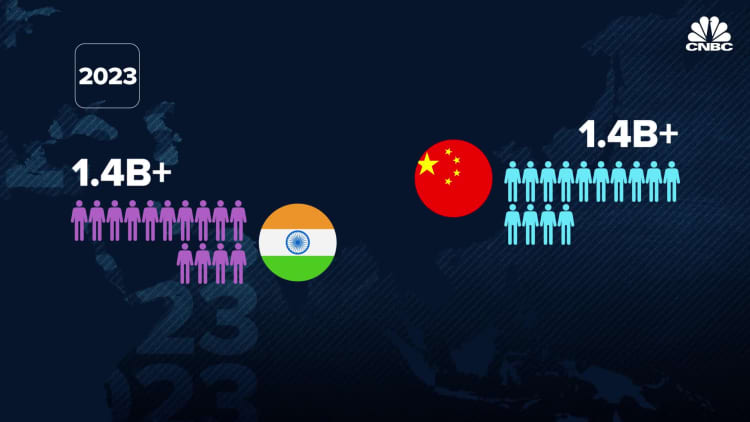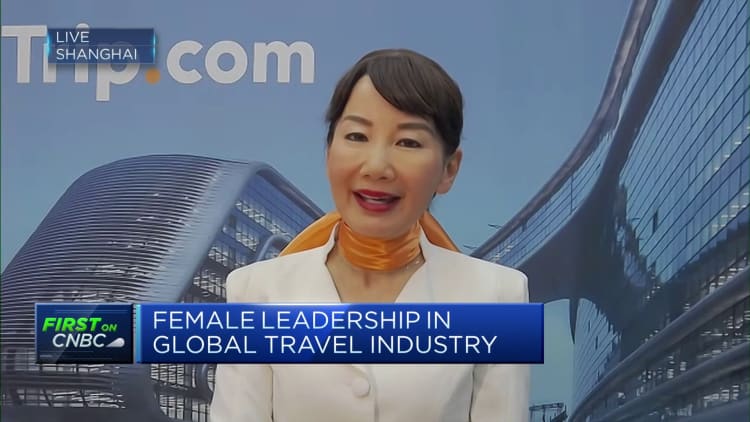[ad_1]
A baby sits in a pram on Tiananmen Square in Beijing on November 17, 2013.
Ed Jones | AFP | Getty Images
As China tries to slow its demographic decline, women like Chen Luojin could be part of the solution.
The divorced 33-year-old lives in Chengdu, capital of the southwestern Sichuan province, which legalized registration of children by unmarried women in February, something China is considering implementing nationwide to address record low birth rates.
The changes mean unmarried women can take paid maternity leave and receive child subsidies previously only available to married couples. Crucially, Chen could access in-vitro fertility (IVF) treatment legally in a private clinic.
She is now 10 weeks pregnant.
“Becoming a single parent is not for everyone, but I’m happy with the decision,” said Chen, who works in logistics. “Equally, getting married or not is for each individual to decide. We have liberalized the policies here and I know a lot of single women are doing IVF.”
Concerned about China’s first population drop in six decades and its rapid ageing, the government’s political advisers proposed in March that single and unmarried women should have access to egg freezing and IVF treatment, among other services. China’s leaders have not commented publicly on the recommendations.

Liberalizing IVF nationwide could unleash more demand for fertility treatment in what is already the world’s biggest market, straining limited fertility services. Some investors in the industry see an opportunity to expand.
“If China changes their policy to allow single women to have children, this can result in an increase of IVF demand,” said Yve Lyppens, director of business development for Asia Pacific at INVO Bioscience, which is awaiting regulatory approval to launch its IVF technology in China after signing a distribution agreement with Guangzhou-based Onesky Holdings last year.
“However, if there is a sudden increase, China will have an even larger capacity issue.”
China’s National Health Commission (NHC) did not respond to a request for comment about liberalizing IVF access, though it has previously acknowledged that many young women are delaying plans to marry and have children, noting that high costs of education and child-rearing have contributed to declining marriage rates.
The NHC’s Sichuan branch did not address questions from Reuters about whether it would offer IVF treatment to all women in public hospitals. When it announced the changes in February, Sichuan’s NHC said they aimed to “promote long-term and balanced population development.”
Shanghai and the southern Guangdong province have also permitted unmarried women to register their children but IVF services for single women remain banned.
Huge unmet need
Lyppens said most IVF clinics in China operated at full capacity before the COVID-19 pandemic, and are likely to be in a similar situation again soon as the country has lifted virus-related curbs. There are no estimates for how many patients want but cannot access treatment, but some women benefiting from it say they spend hours waiting for their turn.
“The queues in the hospital are very long,” said 34-year-old Xiangyu, a married woman undergoing IVF in Chongqing, some 300 kilometers (186 miles) east of Chengdu. She spoke on the condition of partial anonymity for privacy reasons.

Chinese hospitals and clinics, both public and private, provide about 1 million rounds of IVF treatment — or cycles — annually, compared with 1.5 million in the rest of the world, according to academic journals and industry experts.
The price for a cycle — which involves medication for ovarian stimulation, egg collection, insemination in a laboratory and embryo transfer — is regulated in China. It ranges between $3,500 and $4,500, about a quarter of U.S. prices.
China has 539 public and private IVF facilities, and the NHC has said it aims to set up one facility for every 2.3 million people by 2025, which would take the total above 600.
China’s IVF market, including treatment, drugs and equipment, is expected to grow at a compound annual rate of 14.5% in coming years, nearly doubling to 85.4 billion yuan ($12.4 billion) in 2025 from 49.7 billion yuan, research house Leadleo estimated in a report last year. Vivian Zhang, managing director of Merck China MRCG.DE, which provides fertility products and services for IVF clinics in the country, said cities in the less-affluent inland provinces are quickly developing fertility centers similar to those in Beijing and Shanghai.
“There is a huge unmet medical need for Chinese patients,” said Zhang, adding she was “very optimistic” about the IVF market in China.

Gender power imbalances, the stigma in Chinese society that single pregnant women face, and the lack of social surveys make it difficult to quantify total demand and how much it would grow should the reforms be introduced in the near future, industry experts say.
But proxies exist.
Camila Caso, director of platform at Recharge Capital, which invests in fertility clinics and technology, said 500,000 IVF cycles are provided to Chinese women annually in clinics in other countries – a third of all cycles outside China.
Many Chinese women prefer clinics abroad if they are single, or if they want to do various genetic tests or choose the sex of the child, Caso said. A three-decade-old Chinese law designed to address a gender imbalance bars parents from learning the sex of a fetus.
The country implemented a rigid one-child policy from 1980 until 2015 — the root of many of its demographic challenges that have allowed India to become the world’s most populous nation. The limit has since been raised to three children.
In this 2018 photo, a poster in Chinese promoting in vitro fertilization is displayed in the lobby of Piyavate Hospital in Bangkok, which specializes in fertility treatment.
Lillian Suwanrumpha | AFP | Getty Images
Caso said her fund was currently rolling out two clinics in Bangkok and Kuala Lumpur and aims to have around 15 in Thailand, Malaysia and Singapore in the next three to four years. The fund is not investing in China because of uncertainty over IVF incentives, she said, adding that Recharge could capture Chinese demand via the Southeast Asian market.
Lu Weiying, a Chinese political adviser and chief expert at the Reproductive Medical Center of Women and Children in China’s southern Hainan province, said she submitted a proposal to the country’s leaders in March to give single women access to egg freezing, a procedure more and more people were seeking.
“People in China are marrying and having children much later than previously, which has led to an increase in infertility, miscarriage and increased risk of fetal abnormalities,” she said.
More choices for women
In the United States, the average success rate of an IVF cycle is 52%, the Society for Assisted Reproductive Technology says.
In China, the rate is a little over 30%, due in part to high levels of stress among women and a rising average age for having children, said Lin Haiwei, director of Beijing Perfect Family Hospital, which specializes in fertility treatments. Overseas experts say the quality of some IVF laboratories in China is also lower.

Improving access to fertility services won’t fix China’s demographic problem on its own, with factors from low incomes to expensive education, a feeble social safety net and high gender inequality needing more attention, according to population experts.
But it can still make an impact.
Lin estimates that already around 300,000 babies are born in China via IVF annually – some 3% of newborns.
“I believe a related policy will come out in the near future that can satisfy many people’s desire to have a child,” Lin said.
While more Chinese women have postponed or given up on having babies in recent years, many still want to become mothers.
Joy Yang, a 22-year-old international finance major from Hunan province, said she first heard of IVF on television and she wants it liberalized nationwide, in case she does not find a partner but her financial situation allows her to have a child.
“There are some women who don’t want to get married but they still want to have children. I might choose to do IVF,” said Yang.
[ad_2]

